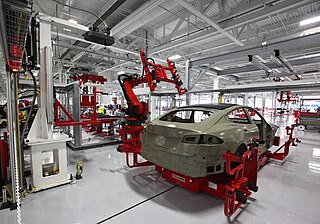 W
WManufacturing is the production of goods through the use of labor, machines, tools, and chemical or biological processing or formulation. It is the essence of secondary sector of the economy. The term may refer to a range of human activity, from handicraft to high-tech, but it is most commonly applied to industrial design, in which raw materials from the primary sector are transformed into finished goods on a large scale. Such goods may be sold to other manufacturers for the production of other more complex products, or distributed via the tertiary industry to end users and consumers.
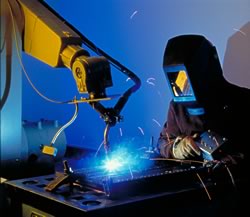 W
WAdvanced manufacturing is the use of innovative technology to improve products or processes, with the relevant technology being described as "advanced," "innovative," or "cutting edge." Advanced manufacturing industries "increasingly integrate new innovative technologies in both products and processes. The rate of technology adoption and the ability to use that technology to remain competitive and add value to define the advanced manufacturing sector."
 W
WThe Boeing Everett Factory is an airplane assembly facility built by Boeing in Everett, Washington, United States. It sits at the northeast corner of Paine Field and includes the largest building in the world by volume at 13,385,378 m3 and covers 98.7 acres (39.9 ha). The entire complex spans both sides of State Route 526. The factory was built in 1967 for the Boeing 747 and has since been expanded several times to accommodate new airliners, including the 767, 777, and 787 programs.
 W
WDesign for manufacturability is the general engineering practice of designing products in such a way that they are easy to manufacture. The concept exists in almost all engineering disciplines, but the implementation differs widely depending on the manufacturing technology. DFM describes the process of designing or engineering a product in order to facilitate the manufacturing process in order to reduce its manufacturing costs. DFM will allow potential problems to be fixed in the design phase which is the least expensive place to address them. Other factors may affect the manufacturability such as the type of raw material, the form of the raw material, dimensional tolerances, and secondary processing such as finishing.
 W
WDry mortar production line is a set of machinery that produces dry mortar for construction industry and other uses. It is mainly composed of elevator, premix bin, stock bin, mixing engine, finished product warehouse, packer, dust collector and electric control cabinet.
 W
WFast Radius is a company that provides manufacturing services in four main areas: application discovery, product design and testing, production-grade manufacturing, and global fulfillment. Its on-demand manufacturing capabilities include additive manufacturing, or 3D printing, CNC machining, injection molding, and urethane casting. Fast Radius’ headquarters is located in Chicago, Illinois, with additional facilities located in Atlanta, Georgia; Louisville, Kentucky; and Singapore. Fast Radius operates a digital Cloud Manufacturing Platform that allows users to order parts and manage the product lifecycle from product development through fulfillment.
 W
WIndustrial engineering is an engineering profession that is concerned with the optimization of complex processes, systems, or organizations by developing, improving and implementing integrated systems of people, money, knowledge, information and equipment. Industrial engineering is central to manufacturing operations.
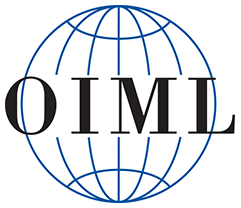 W
WThe International Organization of Legal Metrology, is an intergovernmental organization that was created in 1955 to promote the global harmonization of the legal metrology procedures that underpin and facilitate international trade.
 W
WJob shops are typically small manufacturing systems that handle job production, that is, custom/bespoke or semi-custom/bespoke manufacturing processes such as small to medium-size customer orders or batch jobs. Job shops typically move on to different jobs when each job is completed. Job shops machines are aggregated in shops by the nature of skills and technological processes involved, each shop therefore may contain different machines, which gives this production system processing flexibility, since jobs are not necessarily constrained to a single machine. In computer science the problem of job shop scheduling is considered strongly NP-hard.
 W
WA knock-down kit is a collection of parts required to assemble a product. The parts are typically manufactured in one country or region, then exported to another country or region for final assembly.
 W
WLean manufacturing is a production method aimed primarily at reducing times within the production system as well as response times from suppliers and to customers.
 W
WThe Louisenthal Paper Mill or Papierfabrik Louisenthal in regional language, as a manufacturer of banknotes and security paper. Founded in 1878, the company has been a subsidiary of Giesecke + Devrient since 1964. The mill is best known as a manufacturer of banknotes.
 W
WThe project to create the International Space Station required the utilization and/or construction of new and existing manufacturing facilities around the world, mostly in the United States and Europe. The agencies overseeing the manufacturing involved NASA, Roscosmos, the European Space Agency, JAXA, and the Canadian Space Agency. Hundreds of contractors working for the five space agencies were assigned the task of fabricating the modules, trusses, experiments and other hardware elements for the station.
 W
WA marudai meaning "round stand" is the most common of the traditional frames used for making kumihimo, a type of Japanese braid.
 W
WThe Michoud Assembly Facility (MAF) is an 832-acre manufacturing complex owned by NASA in New Orleans East, a district within New Orleans, Louisiana, in the United States. Organizationally it is part of NASA's Marshall Space Flight Center, and is currently a multi-tenant complex to allow commercial and government contractors, as well as government agencies, to use the site.
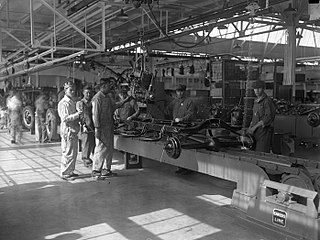 W
WOperations management is an area of management concerned with designing and controlling the process of production and redesigning business operations in the production of goods or services. It involves the responsibility of ensuring that business operations are efficient in terms of using as few resources as needed and effective in meeting customer requirements.
 W
WAn original equipment manufacturer (OEM) is generally perceived as a company that produces parts and equipment that may be marketed by another manufacturer.
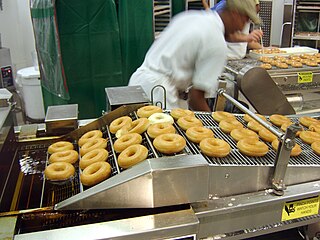 W
WA production line is a set of sequential operations established in a factory where components are assembled to make a finished article or where materials are put through a refining process to produce an end-product that is suitable for onward consumption
 W
WThe productivity-improving technologies are the technological innovations that have historically increased productivity.
 W
WA reconfigurable manufacturing system (RMS) is one designed at the outset for rapid change in its structure, as well as its hardware and software components, in order to quickly adjust its production capacity and functionality within a part family in response to sudden market changes or intrinsic system change.
 W
WA resist, used in many areas of manufacturing and art, is something that is added to parts of an object to create a pattern by protecting these parts from being affected by a subsequent stage in the process. Often the resist is then removed.
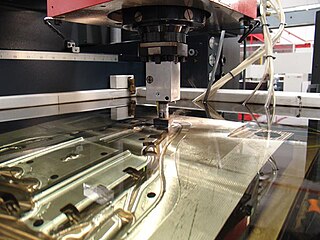 W
WElectrical discharge machining is one of the most accurate manufacturing processes available for creating complex or simple shapes and geometries within parts and assemblies. A machining method typically used for hard metals, EDM makes it possible to work with metals for which traditional machining techniques are ineffective.
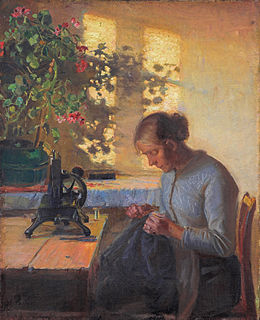 W
WSewing is the craft of fastening or attaching objects using stitches made with a sewing needle and thread. Sewing is one of the oldest of the textile arts, arising in the Paleolithic era. Before the invention of spinning yarn or weaving fabric, archaeologists believe Stone Age people across Europe and Asia sewed fur and leather clothing using bone, antler or ivory needles and "thread" made of various animal body parts including sinew, catgut, and veins.
 W
WA shop floor is the area of a factory, machine shop, etc. where people work on machines, or the space in a retail establishment where goods are sold to consumers. The term shop floor is in contrast to office, which is a space that provides accommodation to the business's management.
 W
WSmart manufacturing is a broad category of manufacturing that employs computer-integrated manufacturing, high levels of adaptability and rapid design changes, digital information technology, and more flexible technical workforce training. Other goals sometimes include fast changes in production levels based on demand, optimization of the supply chain, efficient production and recyclability. In this concept, as smart factory has interoperable systems, multi-scale dynamic modelling and simulation, intelligent automation, strong cyber security, and networked sensors.
 W
WA smokestack industry is a basic, usually cyclical, manufacturing industry. The factories stereotypically used in such industries that have flue gas stacks, hence the name, and produce a high volume of pollution. During the earliest era of electric power development, coal fired electric stations in urban areas were common prior to the use of Alternating current for lighting as Direct current electricity could only travel short distances.
 W
WThe Space Station Processing Facility (SSPF) is a three-story industrial building at Kennedy Space Center for the manufacture and processing of flight hardware, modules, structural components and solar arrays of the International Space Station, and future space stations and commercial spacecraft. It was built in 1992 at the space complex's industrial area, just east of the Operations and Checkout Building.
 W
WA sweatshop or sweat factory is a crowded workplace with very poor, socially unacceptable or illegal working conditions. Some illegal working conditions include poor ventilation, little to no breaks, inadequate work space, insufficient lighting, or uncomfortably high temperatures. The work may be difficult, tiresome, dangerous, climatically challenging or underpaid. Workers in sweatshops may work long hours with unfair wages, regardless of laws mandating overtime pay or a minimum wage; child labor laws may also be violated. Women make up 85 to 90% of sweatshop workers, some employers force them to take birth control and routine pregnancy tests to avoid supporting maternity leave or providing health benefits. The Fair Labor Association's "2006 Annual Public Report" inspected factories for FLA compliance in 18 countries including Bangladesh, El Salvador, Colombia, Guatemala, Malaysia, Thailand, Tunisia, Turkey, China, India, Vietnam, Honduras, Indonesia, Brazil, Mexico, and the US. The U.S. Department of Labor's "2015 Findings on the Worst Forms of Child Labor" found that "18 countries did not meet the International Labour Organization's recommendation for an adequate number of inspectors."
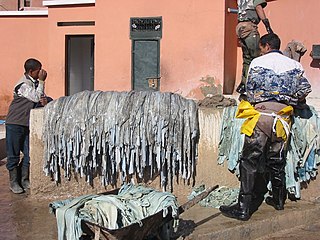 W
WTanning is the process of treating skins and hides of animals to produce leather. A tannery is the place where the skins are processed.
 W
WA transfer line is a manufacturing system which consists of a predetermined sequence of machines connected by an automated material handling system and designed for working on a very small family of parts. Parts can be moved singularly because there’s no need for batching when carrying parts between process stations. The line can synchronous, meaning that all parts advance with the same speed, or asynchronous, meaning buffers exist between stations where parts wait to be processed. Not all transfer lines must geometrically be straight lines, for example circular solutions have been developed which make use of rotary tables, however using buffers becomes almost impossible.
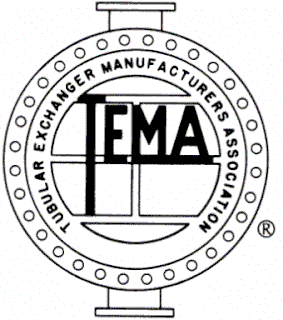 W
WThe Tubular Exchanger Manufacturers Association is an association of fabricators of shell and tube type heat exchangers. TEMA has established and maintains a set of construction standards for heat exchangers, known as the TEMA Standard. TEMA also produces software for evaluation of flow-induced vibration and of flexible shell elements. TEMA was founded in 1939, and is based in Tarrytown, New York. The association meets regularly to revise and update the standards, respond to inquiries, and discuss topics related to the industry.